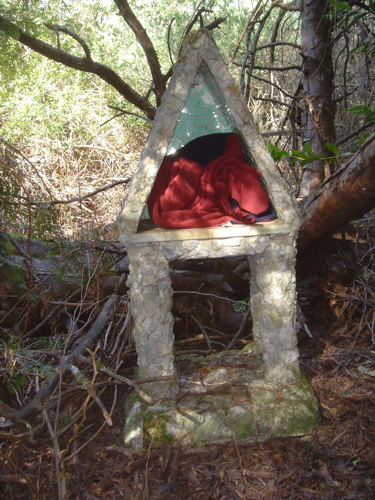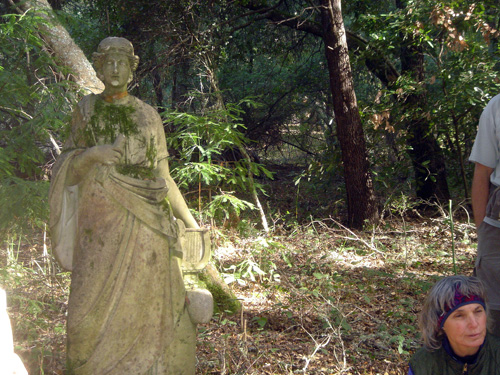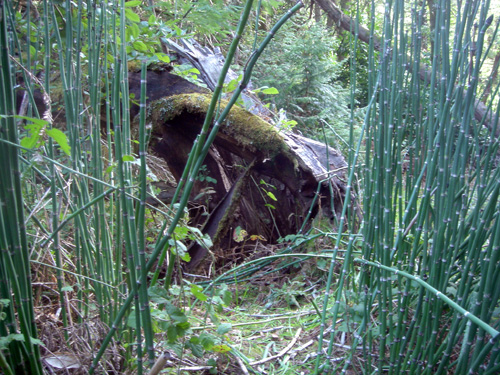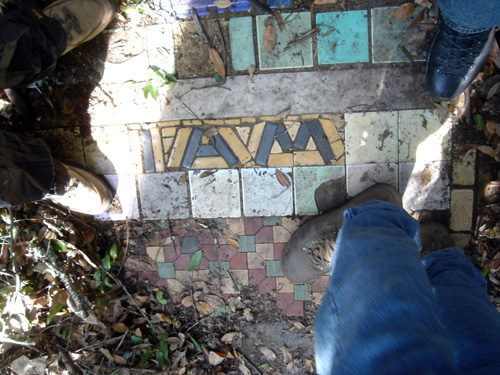
At the very end of Postsingular, I make everything in nature become alive by giving everything endless memory. And now I’m gearing up for a sequel with working title After Everything Woke Up. In my notes I call the two novels PS1 and PS2 for short. Right now I’m busy figuring out how to write a sequel in a world that’s turned so weird and panpsychic.
I guess we’d adjust. Already my car talks to me, so does my phone, my computer, and my refrigerator, so I guess we could live with talking rocks, chairs, logs, sandwiches. But they’d be really smart, not like chirping electronic appliances, which is really kind of different.

How did everything wake up? The technique has to do with strumming a magic harp to unfurls the wastefully rolled-up eighth dimension of space, creating an extra axis upon which any particle or system can store bits about its previous states. This works because (in my opinion):

Life = universal computation + memory

The more I look at things like air currents, swaying trees and, above all, flowing water, the more I become convinced that in fact the majority of analog natural processes are class four and (probably) universal.
But there is something missing in a brook or a swaying tree or a flame, something that keeps it from being alive in the sense that we use the word. And the burden of this ongoing SFictional thought experiment of mine is to present the missing piece as being memory. If this is too confusing, just think of everything being a quantum computation, and all you need for that is atoms and perhaps light.
As I say, I’m still figuring out how wind, trees, weather, fire will act once they “wake up.” Given the ubiquity of quantum computation, in fact every object will be conscious once the eighth dimension is unrolled. Forest fires will be better at spreading, but perhaps trees will be better at not catching fire. Small objects really will hide under the dresser as I already suspect they do.
And the cursed plague of digital electronic computers will wither away.

In Postsingular I had some higher-level AIs called beezies. Very useful agents in the (then) digital web. So at the time of the Great Awakening, I’m gonna have the beezie migrate into physcial processes. Like a pond, a breeze, a tree, and a campfire.
What would a tree or campfire or waterfall beezie be into? What if they just hang out, feeling that doing nothing is truly more interesting than rushing around like a fidgeting monkey. Final enlightenment is a campfire by a pond with a pine tree. “I only learn to be contented,” as it said on the fountain by the Zen garden at Ryoanji in Kyoto. Well, that’s too limp for commercial SF. Fine. And then some evil cynical developer-media-mogul-peasant types are gonna want to exploit their computational potential. “Get to work on those spreadsheets for the Great Attractor galaxy cluster!”

Philsophers have discussed a certain problem with panpsychism is this: why is there a dovetailing that fits together, say, the collective wills of, atoms, machine parts, subassemblies, automobiles, and traffic streams? Why do my cells happen to want to do what my brain wants for my body? Solution: everyone’s idea of their motives and decisions are Just So stories confabulated ex post facto to create a narrative for what is in fact a deterministic supercomputation. Like our illusion of free will. Of course everythingl fits. “We don’t have to get it together. It is together.”

I need a generic word for an uplifted awakened object. A grom. A thunk. A glowie. A sprite. A shoat. A sylph, sylp, silp. Silp might work.
I’m concerned that it might make no functional difference for there to be consciousness in earth (lava, geology), air (wind, vortices), water (falls, riffles), and fire (flames and more generally plants). For it seems like these things have no effectors.
Lazy eight provides sensors, yes, but, lacking effectors, objects seem unable to “do.” They’re stuck being deterministic. But, hmm, thanks to lazy eight, they can in fact write to memory. And to the memories of others. So if they can convince motile agents to do things, then they do functionally have effectors. They can “slave” other objects to act as robot remotes. Plants already do this with insects. They get the insects to move their pollen around.

More directly, I might think of silps as quantum computations and say that they do in fact have effectors in that they can change their own matter, perhaps by affecting rates of catalysis, quantum collapses and so on.
If there’s intelligent quantum computation inside a fire, you might see, say, a fire with square flames. Or wavier. Something subtler. Less smoke. It picks up every trick, thanks to the local air slips helping the fire silp.

[Tiles in the ruins where Swann took us spell out one of God’s few direct quotes, “I AM.”]
If the silps control their own matter somewhat via quantum computation — if, in other words, every object is to some extent its own effector — then, say, a drinking glass might be harder to break than before. The glass sheds off the vibration phonons in optimal ways so as to avoid catastrophic fracture. Assuming a glass minds being broken. A bean that slyly rolls away to avoid being cooked — sometimes in the kitchen, objects do seem to want to run away.
Does a log mind being burned? It would be a drag if you had to feel guilty about stoking your fire. But maybe silps aren’t so bent on self-preservation? We humans (and animals) have to be like that, so we can live long enough to mate and to raise our young. Otherwise we go extinct. But a log or rocks individual survival doesn’t effect the survival of the race of logs or rocks. Though I suppose if logs were impossible to burn, fewer trees would be sawed down, which would be perhaps a good thing from the viewpoint of the logs.

[Here’s my old SJSU professor colleague Howard Swann. Last week, or maybe it was two weeks ago, he and his wife Anita Dyer took about 30 of us on an amazing hike into the oak-grown gullies of the Santa Cruz Mountains near Glenwood Road.]
Re. the topic of talking to objects, here’s a quote from Finnish poet Pentti Saarikoski’s “The Dance Floor on the Mountains,” translated by my Finnish-American poet friend Anselm Hollo:
I would like to be a poet whose song
gets the stones moving
to organize themselves
into a city wall
the trees walking
to carpenters
who build dwellings for people

Bruce Sterling recently sent me a link to this nanotech photo, celebrating the fact that he and I recently finished our story “Hormiga Canyon,” which is about string theory, giant ants, and Los Angeles.









January 13th, 2007 at 4:53 pm
interesting questions
maybe there is no need in the story to identify consciousness so tightly with an object. e.g., when a log burns the consciousness identified locally there might experience a great release into the freedom of being the air, and then a merging into the consciousness of the air which previously in sensed only dimly.
i’m also wondering if you are looking at, or have already looked at the idea: when something like a human dies that it may ghost for sometime as the memory persists in the matter that made up the body? Could a body reform itself?
it seems to me, and I think you may be thinking something similar, that consciousness centered in different kinds of objects would have differnt motivations. does a rock need to be unhappy in the same way a human might be if s/he never moved? Would objects made conscious be happy, or it would it still only be humans that are unhappy with their fate?
January 15th, 2007 at 2:54 pm
While I was reading your ideas for the new book I couldn’t help but think about Alan Moore’s historic run on Swamp Thing during the 80’s. If you haven’t read it I think you’d find it very interesting. The entire story arc
covers 7 volumes (more than 40 comics) but it’s worth it. Towards the end
some of the SF extrapolation was very avant garde.
By the way I love your groovy site (or should I say wavy).
January 17th, 2007 at 4:55 am
Rudy, did you ever read Zelazny’s “The Great Slow Kings?” The mammals have to stand in the throne room for generations while the dino-like overlords ponder, finally going extinct before the question is answered. Silps might not be on our time at all.
I think about memory and consciousness a lot; my son has a pervasive developmental disorder. As a baby he had as much memory and processing power as any other child, but for some reason he didn’t start using it for a few years (he’s 22 and codes web pages now). So giving a rock the power to think might not be enough. I’d say you need installed software along with the lazy-8 memory or you’d have a zen rock garden that did its own meditating.
And why would each pebble have its own memory? More efficient to have all rocks share a big memory, and all fire, etc. So the beans might roll away from the pot, but when you boiled them they’d just make their last entry to the log, or upload themselves to virtual beandom. Your socks might be in a chatroom as you walk to work, griping about your cheap detergent. Fires are too transient; they’d see their inevitable entropic destruction as soon as they became sentient and panic, try to spread, so it would be better for them to be part of one Universal Fire. Light a match and talk to it; the next match remembers your question. Branca could do a symphony for 100 guitars without hiring guitarists, and maybe if he played the same guitar enough it would compose a sonata without him.
Really, I think talking silps would be rare, and silps with something to say even rarer. And you might have to give them a nudge to start them off thinking. Probably someone with a wizard hat, going along with a wand and tapping rocks and streams and waking them up. Didn’t Treebeard say Tolkien’s elves wanted to wake everything up and talk to it?
November 23rd, 2007 at 5:49 pm
Nice Article on panpsychism by journalist Jim Holt in the NY Times magzine last Sunday. I wonder if he reads my blog. I did a search on Holt, and he writes about lots of issues that interest me. Would be nice to meet him some day. He wrote a book on the history of the idea of infinitesimally small quantaties, Worlds Within Worlds, that was published (maybe) by Four Walls Eight Windows but is now unavailable in the US. There is a British edition from Fourth Estate. I may order it from the UK, which seems like a hassle. If Jim Holt is reading this, I’d love to get a copy of your book in exchange for any of my books you want!
Thanks to Nick Herbert for tipping me off about the article.
November 25th, 2007 at 11:51 pm
by asking the ‘right’ question, we bounce The Mind into an answer to what we really want. the questions are wrong, but why? but we swim against the magnetic field hiding the right question. i think we are approaching the right question, it’s a huge (“massive”) metaphoric-linkage in the mind of “god” (The MindSystem, ie This Place), it’s not just Moore’s Law and Vingean Inevitability or McKenna’s 2013 — it’s all of that and it’s the feeling of directing the Mind at a kind of weak-spot or ‘bug’ being debugged, a thought that is removed every time we get closer to thinking it.
“we are in some kind of lucid-dream cybernetic simulator: it has glitches, giveaways, oops-es, trapdoors, goofy jokes, and wierd markings made by intrepid explorers from the pasts and futures. oh yeah, timespace is BIG, too.”
December 20th, 2007 at 3:40 pm
“Tina Darragh – Collective Lament for Banishing Animals from History (2’20”). As the lexical surface perforates, and smug assumptions about our species, its history and boundaries, dissolve, the noises of the one big animate union steal through, creaking and buzzing and clucking. Great performance of an amazing poem. • Recorded 25 January 2007 at the University of Maine (some ambient office sounds audible, appropriately enough).”
from soundpoetry site http://www.thirdfactory.net/lipstick.html#feb9